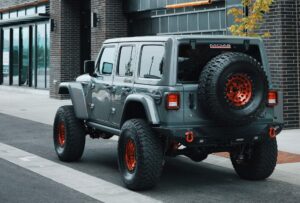The locking differential system is one of the most common differential systems in the world when it comes to distributing torque and drive in a vehicle.
One thing most people might not know though is that when it comes to performance it might not be the best option available.
If you have had a chance to drive high-performance vehicles like the Ford Mustang, you have come across a different high performance differential system, which is the limited-slip differential system.
In terms of overall performance, the limited-slip differential is easily a better option compared to the locking differential and we are going to be discussing why in this article.
Contents
What is a Limited Slip Differential?
The working principle behind the limited-slip differential is mainly focused on reducing slipping as the name suggests.
Most vehicles that come with the limited-slip differential system right now come with automatic activation.
This means that you do not have to manually activate the system. The system works in a simple way where it controls how torque is distributed between the wheels.
If you are not familiar with the term torque, it simply describes the rotational force on the wheels of a vehicle by the engine.
The limited-slip differential system helps to reduce or increase the torque of wheels depending on the surface that the wheel is rotating on.
The limited-slip differential exists mainly in two forms or types, that is the mechanical clutch disc limited-slip differentials and the viscous limited slip differential.
The former uses a similar mechanism to that of the locking differential system with the only difference being a pair of pressure rings that exert pressure on the clutch plates.
The viscous limited-slip differential uses a viscous liquid. The working principle of both types of limited-slip differential is pretty much the same.
Mechanism of Limited Slip differential
The driving principle behind the limited-slip differential is that torque is directed to the wheels with the most traction.
This will in turn increase vehicle drive. If there is traction, there is a need to have more torque. This means that when the system is activated more torque will be provided to the wheel with the most traction.
This means by focusing engine power to the wheels with more traction we can make up for the loss of traction on the other wheel.
An example where this is most effective is when one wheel is on a slippery surface and one is not. The wheel on the slippery surface will lose traction and will have less traction compared to the other wheel on the surface that is not slippery.
If torque is shared, equally to both wheels, the wheels on the slippery surface will end up spinning without necessarily moving due to the low traction.
Due to this aspect, the limited-slip differential will result in torque being driven to the wheel that is not on the slippery surface.
More torque will result in the wheel with more traction spinning more frequently and moving faster. This allows for vehicles that are stuck to easily maneuver out of slippery surfaces thanks to the fact that the wheels that have more traction get more power and in turn more spins.
Having torque on a wheel that is stuck on a slippery surface is in a way a waste of power as the wheel will not move but just spin in one position.
This mechanism is very useful in uneven terrains as well as slippery surfaces like mud and ice.
Advantages Of Limited Slip Differential
Several advantages come with using the limited-slip differential system for your vehicle. The first one is
Consistent Movement
The tag line for the limited-slip differential has to be, “We move!”
This is because the main principle backing the system means that regardless of the terrain being slippery or uneven a vehicle that is equipped with the limited-slip differential will keep moving.
The balance that the system applies when it comes to torque distribution means that the wheel with the most traction gets the most torque.
This means that regardless of the terrain your car is stuck in there will be more torque on the wheel with the most traction and this will allow for that will drive the vehicle out of whatever situation that it is stuck in.
The mechanism is essentially fail-proof.
Tire Wear Reduction
If you have a high-performance SUV then you will agree with us that tire wear is a big deal. One thing the limited-slip differential will help you avoid has to be tire wear.
Remember that the limited-slip differential will direct torque to the wheel that has the most traction. This means that the wheel with the least traction will not be forced to move and will have limited torque.
This will reduce the friction that the wheel will have to experience and will in turn reduce wear. Off-road, driving is terrible for your tires and if you do not have a limited-slip differential system it is bound to be worse for your tires.
Noise Cancelation
This is one of the least talked about benefits of the limited-slip differential but that does not make it any less important.
One thing about the limited-slip differential is that it reduces the noise during your off-road driving. One of the most annoying noises that drivers have to experience has been the noise of a wheel that is spinning in one place.
With the limited-slip differential, this is one thing that you won’t have to worry about or even deal with. This is because the wheel with the most torque will be moving and will essentially be acting like a normal driving wheel. Amazing, right?
You can know the pros and cons of using Limited-Slip Differentials for off road driving , through this detailed guide.
Disadvantages of Limited Slip Differential
There are not many disadvantages stat come with using the limited-slip differential. The main problem that people who have been using the limited-slip differential have come across include
Limited Power
We have already highlighted that when your vehicle is stuck in a slippery situation, the torque of your vehicle will be directed to the end that is not on the slippery point.
Well, one thing that we have to state is that one wheel or three wheels cannot handle the full torque of a vehicle.
As a result, only a limited amount of power will be provided to the vehicle. This means that if you have a limited differential in place, you might not be able to utilize your vehicle’s full power.
This is a big problem, especially when two or more wheels are on the slippery surface. It might get difficult to move your vehicle out of that position and in some instances, it can be essentially impossible to move it off that position.
Regardless of how strong your engine is, if you have your limited-slip differential activated, chances are you might not be using your engine to its full capacity.
Expense
If your vehicle has a problem with the limited differential system, you are going to have to part with a significant amount of money to get it fixed.
The maintenance cost of the limited-slip differential is significantly higher in comparison to that of the locking system differential.
If your limited-slip differential develops a problem, you might need to fork out around $600 for repairs.
If you get to a point where you need a replacement the costs might dive into the $1000 zone or even more.
Locking Differential
The locking differential uses a different mechanism to the limited-slip differential.
The locking system, unlike the limited-slip differential, will not direct all the torque to the wheel when the terrain becomes slippery; rather, the wheels on one axle will be locked together and torque will be distributed equally between the two wheels.
This means that two wheels will have more drive and will easily push the vehicle forward. In terms of full power, the locking differential allows you to use the maximum power that your vehicle can provide.
This is very important when maneuvering off-road terrain that often requires more drive for your vehicle to be able to move steadily in conditions that are somewhat not favorable.
Advantages of Locking Differential
Several advantages come with using the locking differential. The list is quite extensive but some of the best features that you can look forward to include,
Super Powerful
One thing about the locking differential is that you get all the power when it is activated.
The locking mechanism ensures that all the power that is available for use is utilized when the wheels are locked.
This is very important especially when you are driving on uneven terrain. If you are looking to maximize in terms of power then your best option is to go with the locking differential.
Economic
The locking differential is economic compared to the other differential on the market.
In terms of both installation and maintenance costs, there are no differential options that come close to the locking differential.
When you install the locking differential, there is no need to modify the axle shaft, axle, pinion, or ring. This means that the installation costs are minimal.
This is quite a different story from that of the limited-slip differential. If you want performance that is amazing but on a budget then the locking differential is your go-to system.
The disadvantage of Locking Differential
The main problem that you are going to face if you do decide to go with the locking differential is tire wear.
Remember with the locking differential there is a lot of force thanks to the locking action that is done on the wheels. Even if the terrain is slippery and traction is low there is going to be an equal amount of torque going into the wheels.
This means that there is going to be a lot of friction on the wheels. This will increase wear and tear especially in the tire section.
When it comes to icy roads, the locking differential is also not your best option. If all the wheels are turning at the same speed including the one that does not have traction, your chances of getting out of a slippery surface are quite low.
Verdict
In terms of picking a winner between the two, it is difficult. The limited slip differential ensures that you do not slip when driving on mud or icy road surfaces.
With the locking differential, you are assured of maximum power from your vehicle and a lot of saving on the financial side of things.
Depending on your budget and where you plan to drive your vehicle both will work quite well.
If we were to pick between the two, the limited slip differential would win narrowly.
Whichever differential option you pick it is important to note that tire size, engine power, and suspension also play a role when it comes to your driving experience. The driving experience is not the sole responsibility of the differential.
Enjoy the best of driving!



